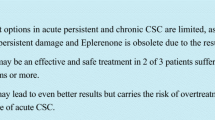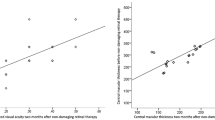Abstract
Purpose
To compare functional and morphological outcomes of Subthreshold Laser (STL) and Oral Spironolactone (SPR) in treating chronic central serous chorioretinopathy (CSCR).
Methods
This is a retrospective observational study. Treatment-naïve patients with chronic CSCR treated with STL or SPR were included, and data was reviewed at baseline, 1, 3, 6 and 12-month follow-up. Main outcome measures were changes in Central Macular Thickness (CMT) and Subretinal Fluid (SRF) height, and complete resolutions of SRF. Sub-analysis based on retinal pigmented epithelium (RPE) status at baseline was performed.
Results
47 and 47 patients received STL and SPR, respectively. At all timepoints, both treatments significantly improved CMT and SRF (p < 0.05). No significant changes in best corrected visual acuity (BCVA) were recorded and no significant differences between treatment groups were present at each corresponding follow-up. Complete resolution of SRF was achieved in 29% and 36% of patients treated with STL or SPR, respectively, at 12-months follow up.
Eyes treated with STL and intact RPE showed significant SRF decrease at 6 months and significantly better BCVA at 1, 3 and 6 months compared to eyes with disrupted RPE layer (p < 0.05). In both treatment groups, intact RPE was associated with a higher rate of complete SRF resolutions, with 43% vs 13% in the STL group and 50% vs 26% in the SPR group.
Conclusion
STL and SPR are effective treatments for chronic CSCR. Greater resolution of subretinal fluid was observed in eyes with intact RPE, hence both treatments should be initiated in the earlier stages of the disease.



Similar content being viewed by others
References
Daruich A, Matet A, Dirani A et al (2015) Central serous chorioretinopathy: recent findings and new physiopathology hypothesis. Prog Retin Eye Res. https://doi.org/10.1016/j.preteyeres.2015.05.003
Gattoussi S, Freund KB (2017) Multimodal imaging in central serous chorioretinopathy. Ophthalmology. https://doi.org/10.1016/j.ophtha.2017.02.016
Nicholson B, Noble J, Forooghian F, Meyerle C (2013) Central serous chorioretinopathy: update on pathophysiology and treatment. Surv Ophthalmol. https://doi.org/10.1016/j.survophthal.2012.07.004
Ruiz-Medrano J, Pellegrini M, Cereda MG, Cigada M, Staurenghi G (2017) Choroidal characteristics of acute and chronic central serous chorioretinopathy using enhanced depth imaging optical coherence tomography. Eur J Ophthalmol. https://doi.org/10.5301/ejo.5000796
Yannuzzi LA (2010) Central serous chorioretinopathy: a personal perspective. Am J Ophthalmol. https://doi.org/10.1016/j.ajo.2009.11.017
Fung AT, Yannuzzi LA, Bailey FK (2012) Type 1 (Sub-retinal pigment epithelial) neovascularization in central serous chorioretinopathy masquerading as neovascular age-related macular degeneration. Retina. https://doi.org/10.1097/IAE.0b013e3182680a66
Inhoffen W, Ziemssen F, Bartz-Schmidt KU (2012) Chronic central serous chorioretinopathy (cCSC): differential diagnosis to choroidal neovascularisation (CNV) secondary to age-related macular degeneration (AMD). Klin Monatsbl Augenheilkd 229(9):889–896. https://doi.org/10.1055/s-0032-1315077
Pang CE, Freund KB (2015) Pachychoroid neovasculopathy. Retina. https://doi.org/10.1097/IAE.0000000000000331
van Rijssen TJ, van Dijk EHC, Yzer S, Ohno-Matsui K, Keunen JEE, Schlingemann RO, Sivaprasad S, Querques G, Downes SM, Fauser S, Hoyng CB, Piccolino FC, Chhablani JK, Lai TYY, Lotery AJ, Larsen M, Holz FG, Freund KB, Yannuzzi LA, Boon CJF (2019) Central serous chorioretinopathy: towards an evidence-based treatment guideline. Prog Retin Eye Res 73:100770. https://doi.org/10.1016/j.preteyeres.2019.07.003. (Epub 2019 Jul 15 PMID: 31319157)
Ozkaya A, Alkin Z, Ozveren M, Yazici AT, Taskapili M (2016) The time of resolution and the rate of recurrence in acute central serous chorioretinopathy following spontaneous resolution and low-fluence photodynamic therapy: a case–control study. Eye 30(7):1005–1010. https://doi.org/10.1038/eye.2016.79
Baran NV, Gürlü VP, Esgin H (2005) Long-term macular function in eyes with central serous chorioretinopathy. Clin Exp Ophthalmol. https://doi.org/10.1111/j.1442-9071.2005.01027.x
Maaranen TH, Tuppurainen KT, Mäntyjärvi MI (2000) Color vision defects after central serous chorioretinopathy. Retina. https://doi.org/10.1097/00006982-200006000-00009
Loo RH, Scott IU, Flynn HW et al (2002) Factors associated with reduced visual acuity during long-term follow-up of patients with idiopathic central serous chorioretinopathy. Retina. https://doi.org/10.1097/00006982-200202000-00004
Breukink MB, Dingemans AJM, Den Hollander AI et al (2017) Chronic central serous chorioretinopathy: long-term follow-up and vision-related quality of life. Clin Ophthalmol. https://doi.org/10.2147/OPTH.S115685
Wang MSM, Sander B, Larsen M (2002) Retinal atrophy in idiopathic central serous chorioretinopathy. Am J Ophthalmol. https://doi.org/10.1016/S0002-9394(02)01438-1
Verma L, Sinha R, Venkatesh P, Tewari HK (2004) Comparative evaluation of diode laser versus argon laser photocoagulation in patients with central serous retinopathy: a pilot, randomized controlled trial [ISRCTN84128484]. BMC Ophthalmol. https://doi.org/10.1186/1471-2415-4-15
Chen SN, Hwang JF, Tseng LF, Lin CJ (2008) Subthreshold diode micropulse photocoagulation for the treatment of chronic central serous chorioretinopathy with juxtafoveal leakage. Ophthalmology. https://doi.org/10.1016/j.ophtha.2008.08.026
Lanzetta P, Furlan F, Morgante L, Veritti D, Bandello F (2008) Nonvisible subthreshold micropulse diode laser (810 nm) treatment of central serous chorioretinopathy: a pilot study. European J Ophthalmology 18(6):934–940
Gupta B, Elagouz M, McHugh D, Chong V, Sivaprasad S (2009) Micropulse diode laser photocoagulation for central serous chorio-retinopathy. Clin Exp Ophthalmol. https://doi.org/10.1111/j.1442-9071.2009.02157.x
Donati MC, Murro V, Mucciolo DP, Giorgio D, Cinotti G, Virgili G, Rizzo S (2021) Subthreshold yellow micropulse laser for treatment of diabetic macular edema: comparison between fixed and variable treatment regimen. Eur J Ophthalmol 31(3):1254–1260. https://doi.org/10.1177/1120672120915169
Roisman L, Magalhães FP, Lavinsky D, Moraes N, Hirai FE, Cardillo JA, Farah ME (2013) Micropulse diode laser treatment for chronic central serous chorioretinopathy: a randomized pilot trial. Ophthalmic Surg, Lasers Imaging Retina 44(5):465–470. https://doi.org/10.3928/23258160-20130909-08
Kim YJ, Kim SY, Ha S, Moon D, Seong S, Kwon OW, Park HS (2019) Short-duration multiple-session subthreshold micropulse yellow laser (577 nm) for chronic central serous chorioretinopathy: results at 3 years. Eye 33(5):819–825
Bousquet E, Beydoun T, Zhao M, Hassan L, Offret O, Behar-Cohen F (2013) Mineralocorticoid receptor antagonism in the treatment of chronic central serous chorioretinopathy: a pilot study. Retina. https://doi.org/10.1097/IAE.0b013e318297a07a
Breukink MB, den Hollander AI, Keunen JEE, Boon CJF, Hoyng CB (2014) The use of eplerenone in therapy-resistant chronic central serous chorioretinopathy. Acta Ophthalmol. https://doi.org/10.1111/aos.12392
Fraenkel D, Suffo S, Langenbucher A, Seitz B, Abdin AD (2021) Eplerenone for treatment of chronic central serous chorioretinopathy. Eur J Ophthalmol 31(4):1885–1891. https://doi.org/10.1177/1120672120952648
Daruich A, Matet A, Dirani A et al (2016) Oral mineralocorticoid-receptor antagonists: real-life experience in clinical subtypes of nonresolving central serous chorioretinopathy with chronic epitheliopathy. Transl Vis Sci Technol. https://doi.org/10.1167/tvst.5.2.2
Sun Z, Huang Y, Nie C, Wang Z, Pei J, Lin B, Zhou R, Zhang J, Chong V, Liu X (2020) Efficacy and safety of subthreshold micropulse laser compared with threshold conventional laser in central serous chorioretinopathy. Eye (Lond) 34(9):1592–1599
Bousquet E, Beydoun T, Rothschild PR, Bergin C, Zhao M, Batista R, Behar-Cohen F (2015) Spironolactone for nonresolving central serous chorioretinopathy: a randomized controlled crossover study. Retina 35(12):2505–2515
van Dijk EHC, Fauser S, Breukink MB et al (2018) Half-dose photodynamic therapy versus high-density subthreshold micropulse laser treatment in patients with chronic central serous chorioretinopathy: the place trial. Ophthalmology. https://doi.org/10.1016/j.ophtha.2018.04.021
Zola M, Daruich A, Matet A, Mantel I, Behar-Cohen F (2019) Two-year follow-up of mineralocorticoid receptor antagonists for chronic central serous chorioretinopathy. British J Ophthalmol 103(8):1184–1189
Gawęcki M, Jaszczuk-Maciejewska A, Jurska-Jaśko A, Grzybowski A (2017) Functional and morphological outcome in patients with chronic central serous chorioretinopathy treated by subthreshold micropulse laser. Graefe’s Arch Clin Exp Ophthalmol. https://doi.org/10.1007/s00417-017-3783-x
Petkovsek DS, Cherfan DG, Conti FF et al (2019) Eplerenone for the treatment of chronic central serous chorioretinopathy: 3-year clinical experience. Br J Ophthalmol. https://doi.org/10.1136/bjophthalmol-2019-314047
Lotery A, Sivaprasad S, O’Connell A et al (2020) Eplerenone for chronic central serous chorioretinopathy in patients with active, previously untreated disease for more than 4 months (VICI): a randomised, double-blind, placebo-controlled trial. Lancet 395:294–303
Pichi F, Carrai P, Ciardella A et al (2017) Comparison of two mineralcorticosteroids receptor antagonists for the treatment of central serous chorioretinopathy. Int Ophthalmol 37:1115–1125. https://doi.org/10.1007/s10792-016-0377-2
Chan WM, Lam DSC, Lai TYY, Tam BSM, Liu DTL, Chan CKM (2003) Choroidal vascular remodelling in central serous chorioretinopathy after indocyanine green guided photodynamic therapy with verteporfin: a novel treatment at the primary disease level. Br J Ophthalmol. https://doi.org/10.1136/bjo.87.12.1453
Piccolino FC, Eandi CM, Ventre L, de la Longrais RCR, Grignolo FM (2003) Photodynamic therapy for chronic central serous chorioretinopathy. Retina 23(6):752–763
Sirks MJ, van Dijk EHC, Rosenberg N, Hollak CEM, Aslanis S, Cheung CMG, Chowers I, Eandi CM, Freund KB, Holz FG, Kaiser PK, Lotery AJ, Ohno-Matsui K, Querques G, Subhi Y, Tadayoni R, Wykoff CC, Zur D, Diederen RMH, Boon CJF, Schlingemann RO (2022) Clinical impact of the worldwide shortage of verteporfin (Visudyne®) on ophthalmic care. Acta Ophthalmol 100(7):e1522–e1532
Acknowledgements
None
Funding
None.
Author information
Authors and Affiliations
Contributions
SM, FD, BG, PC and SY conceptualized and designed the study; WR, AG and NK collected the data; SM analyzed the data; SM and FD prepared the tables and figures; all Authors contributed to the drafting and revision of the manuscript manuscript.
Corresponding author
Ethics declarations
Conflict of interest
The Authors have no financial/conflicting interests to disclose.
Additional information
Publisher's Note
Springer Nature remains neutral with regard to jurisdictional claims in published maps and institutional affiliations.
Rights and permissions
Springer Nature or its licensor (e.g. a society or other partner) holds exclusive rights to this article under a publishing agreement with the author(s) or other rightsholder(s); author self-archiving of the accepted manuscript version of this article is solely governed by the terms of such publishing agreement and applicable law.
About this article
Cite this article
Mercuri, S., D’Alterio, F.M., Gallo, B. et al. Subthreshold laser compared to oral spironolactone for the treatment of chronic central serous chorioretinopathy: a retrospective study. Int Ophthalmol 44, 131 (2024). https://doi.org/10.1007/s10792-024-03063-3
Received:
Accepted:
Published:
DOI: https://doi.org/10.1007/s10792-024-03063-3




